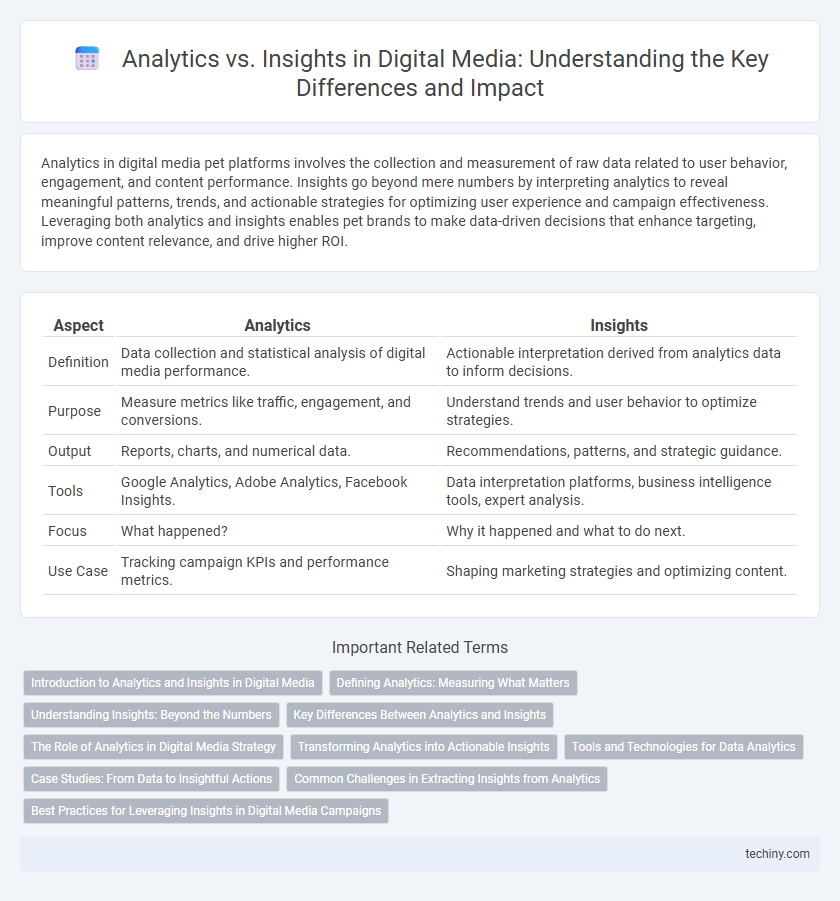Analytics in digital media pet platforms involves the collection and measurement of raw data related to user behavior, engagement, and content performance. Insights go beyond mere numbers by interpreting analytics to reveal meaningful patterns, trends, and actionable strategies for optimizing user experience and campaign effectiveness. Leveraging both analytics and insights enables pet brands to make data-driven decisions that enhance targeting, improve content relevance, and drive higher ROI.
Table of Comparison
| Aspect | Analytics | Insights |
|---|---|---|
| Definition | Data collection and statistical analysis of digital media performance. | Actionable interpretation derived from analytics data to inform decisions. |
| Purpose | Measure metrics like traffic, engagement, and conversions. | Understand trends and user behavior to optimize strategies. |
| Output | Reports, charts, and numerical data. | Recommendations, patterns, and strategic guidance. |
| Tools | Google Analytics, Adobe Analytics, Facebook Insights. | Data interpretation platforms, business intelligence tools, expert analysis. |
| Focus | What happened? | Why it happened and what to do next. |
| Use Case | Tracking campaign KPIs and performance metrics. | Shaping marketing strategies and optimizing content. |
Introduction to Analytics and Insights in Digital Media
Analytics in digital media involves collecting and measuring data from various platforms such as social media, websites, and ad campaigns to track performance metrics like engagement, reach, and conversion rates. Insights go beyond raw data by interpreting patterns, trends, and user behavior to inform strategic decisions and optimize content effectiveness. Understanding the distinction between analytics as data and insights as actionable knowledge is crucial for enhancing digital media strategies and achieving business objectives.
Defining Analytics: Measuring What Matters
Analytics in digital media involves the systematic measurement and evaluation of key performance indicators such as engagement rates, click-through rates, and conversion metrics. This process quantifies user behavior and content effectiveness to determine what resonates with the target audience. Measuring what matters ensures data-driven decisions maximize ROI and optimize campaign strategies.
Understanding Insights: Beyond the Numbers
Analytics in digital media involves collecting and measuring data, while insights go deeper to interpret patterns and predict audience behavior. Understanding insights requires connecting diverse data points to reveal actionable strategies that enhance content engagement and marketing effectiveness. These insights drive informed decision-making by translating raw metrics into meaningful narratives that optimize digital campaign performance.
Key Differences Between Analytics and Insights
Analytics involves the systematic collection and measurement of digital media data such as user engagement, click-through rates, and conversion metrics. Insights refer to the actionable interpretations derived from analytics data, enabling strategic decisions and optimization of marketing campaigns. The key difference lies in analytics providing raw data, while insights translate that data into meaningful understanding to drive business growth.
The Role of Analytics in Digital Media Strategy
Analytics plays a crucial role in digital media strategy by collecting and interpreting data on audience behavior, campaign performance, and content engagement. This data-driven approach enables marketers to make informed decisions, optimize targeting, and enhance ROI through real-time adjustments. By transforming raw analytics into actionable insights, brands can refine their messaging and achieve greater relevance in competitive digital landscapes.
Transforming Analytics into Actionable Insights
Transforming analytics into actionable insights requires extracting meaningful patterns from vast digital media data to inform strategic decisions. Leveraging advanced tools like machine learning and AI enhances the interpretation of user engagement metrics, enabling targeted content optimization. This process bridges raw data analysis with practical business outcomes, driving improved campaign performance and audience growth.
Tools and Technologies for Data Analytics
Data analytics tools such as Google Analytics, Tableau, and Adobe Analytics play a crucial role in collecting, processing, and visualizing vast amounts of digital media data. Advanced technologies like machine learning algorithms and AI-powered platforms enable deeper insights by identifying patterns, trends, and user behaviors that raw analytics alone cannot reveal. Integrating these tools enhances decision-making accuracy, optimizes digital campaign performance, and drives strategic growth in digital media.
Case Studies: From Data to Insightful Actions
Case studies in digital media demonstrate how analytics transform raw data into actionable insights by identifying user behavior patterns and campaign performance metrics. Analyzing metrics like click-through rates, engagement duration, and conversion funnels enables marketers to optimize content strategies and improve ROI. Effective use of analytics tools such as Google Analytics and Adobe Analytics facilitates data-driven decisions that drive targeted marketing efforts and boost audience engagement.
Common Challenges in Extracting Insights from Analytics
Extracting actionable insights from digital media analytics often faces challenges such as data overload, where vast volumes of information obscure meaningful patterns. Inconsistent data quality and incomplete datasets hinder accurate interpretation, leading to potential misinformed decisions. Moreover, the lack of context-aware analysis tools complicates translating raw metrics into strategic insights that drive audience engagement and campaign effectiveness.
Best Practices for Leveraging Insights in Digital Media Campaigns
Effective digital media campaigns rely on transforming raw analytics into actionable insights by focusing on audience behavior, engagement metrics, and conversion patterns. Leveraging data visualization tools and machine learning algorithms enhances the ability to detect trends, optimize content delivery, and personalize user experiences. Implementing continuous testing, real-time monitoring, and cross-channel data integration maximizes campaign performance and drives higher ROI.
Analytics vs Insights Infographic

 techiny.com
techiny.com